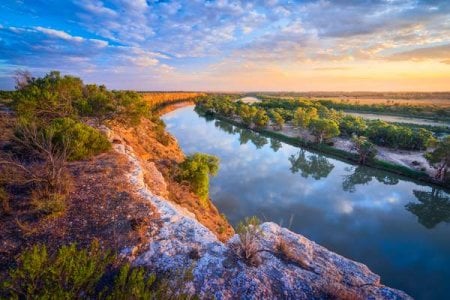Authorities extend health alert as crisis continues to threaten Murray River communities
- Replies 6
In recent months, environmental concerns have been heightened as a persistent issue continues to affect local ecosystems.
A recurring natural phenomenon has drawn attention to the delicate balance of Australian waterways, highlighting the need for ongoing vigilance and management.
This situation underscores the importance of monitoring and addressing environmental challenges to safeguard both the environment and public health.
The Murray River, a lifeblood for many communities and ecosystems, has recently been the subject of a prolonged safety alert that has left residents and visitors on edge.
For over three months, an SA Health alert has been in place for the River Murray at Goolwa and Lake Alexandrina due to the presence of toxic blue-green algae, known scientifically as Cylindrospermopsis raciborskii (also referred to as Raphidiopsis raciborskii).
The algae can lead to gastrointestinal problems and liver damage. The emergence of this algae in temperate areas like South Australia is a relatively new phenomenon, having previously been confined to tropical and subtropical regions.

The situation is particularly concerning because, while the algae itself has seen a 99 per cent reduction, the toxins it releases upon dying remain at high levels.
These toxins are stubborn; they take time to biodegrade and dilute, leaving the water unsafe for recreational activities and posing a risk to livestock that may drink from the affected areas.
Lake Alexandrina, with its vast surface area of about 570 square kilometres, is a critical part of the Murray-Darling Basin and is now facing the largest bloom of this organism ever recorded in South Australia.
David Cunliffe, Principal Water Quality Advisor with SA Health, reported that algae cell counts in the lake had decreased to 1 per cent of their March and April levels.
However, the high levels of toxin released as the algae die will take time to biodegrade and dilute.
‘This was new ground,’ Dr Cunliffe remarked.
‘This is the largest bloom of this organism we've seen in South Australia and certainly the largest bloom of this type in the lake.’
Dr Cunliffe noted that cold weather might be slowing the toxin's biodegradation, making it unclear when the alert could be lifted.
‘We are in nature's hands,’ he said.
‘It's been quite strange because it occurred at the back end of summer, whereas cyanobacteria tended to bloom earlier in the season.’
‘We have seen the organism before but not in these numbers, so this is a unique event,’ Dr Cunliffe added.
He also mentioned that SA Health received several calls from people inquiring about the algae's presence, as it stayed mostly within the water column and did not form visible scum.
Former Principal Microbiologist for SA Water and Emeritus Professor Christopher Saint from the University of South Australia warned that the area would ‘absolutely’ experience a recurrence of the algae, likely blooming again in the warm weather next year.
He noted that when the algae was first detected in South Australia around 15 years ago, he suspected it would ‘be the start of something’.
Professor Saint explained that the increasing number of clear winter days and hotter summer temperatures have contributed to the algae's growth.
‘We’re unwittingly creating these conditions that favour these things,’ he pointed out.
South Australia was experiencing heatwave conditions when the bloom began forming.
Professor Saint explained that breaking open the cells of this type of algae might destroy the bloom, but in bodies of water used for drinking, a holding period would be necessary to use activated carbon to eliminate the toxins.
‘To try and get rid of it in Lake Alexandrina on a large scale like that is not going to be easy,’ he stated.
‘In the natural environment, you haven't really got a lot of options except to let nature take its course.’
Professor Saint mentioned that birds could potentially spread the algae to other water bodies and reservoirs.
Dr Cunliffe stated he did not recall this type of algae being found in the state's drinking water reservoirs but noted that SA Water has the capability to filter, treat, and use methods like chlorination to inactivate any toxins in those bodies of water.
As South Australia grapples with the persistent challenge of toxic algae blooms, another natural phenomenon captured the public's attention.
A stunning transformation turned an Australian beach into a vibrant blue wonderland, raising questions about its safety.
While these visual spectacles draw crowds, it's essential to understand the potential health implications and environmental impacts they may pose.
 We encourage our readers to stay updated on the status of the Murray River and Lake Alexandrina through SA Health and local news sources.
We encourage our readers to stay updated on the status of the Murray River and Lake Alexandrina through SA Health and local news sources.
If you have concerns or questions about the safety of your local waterways, don't hesitate to reach out to local authorities.
Have you been affected by the algae bloom? How are you adapting to these environmental challenges? We invite you to share your thoughts and experiences in the comments below.
A recurring natural phenomenon has drawn attention to the delicate balance of Australian waterways, highlighting the need for ongoing vigilance and management.
This situation underscores the importance of monitoring and addressing environmental challenges to safeguard both the environment and public health.
The Murray River, a lifeblood for many communities and ecosystems, has recently been the subject of a prolonged safety alert that has left residents and visitors on edge.
For over three months, an SA Health alert has been in place for the River Murray at Goolwa and Lake Alexandrina due to the presence of toxic blue-green algae, known scientifically as Cylindrospermopsis raciborskii (also referred to as Raphidiopsis raciborskii).
The algae can lead to gastrointestinal problems and liver damage. The emergence of this algae in temperate areas like South Australia is a relatively new phenomenon, having previously been confined to tropical and subtropical regions.

An ongoing safety alert advises against swimming in the River Murray and Lake Alexandrina due to high toxin levels from decaying blue-green algae. Credit: Shutterstock
The situation is particularly concerning because, while the algae itself has seen a 99 per cent reduction, the toxins it releases upon dying remain at high levels.
These toxins are stubborn; they take time to biodegrade and dilute, leaving the water unsafe for recreational activities and posing a risk to livestock that may drink from the affected areas.
Lake Alexandrina, with its vast surface area of about 570 square kilometres, is a critical part of the Murray-Darling Basin and is now facing the largest bloom of this organism ever recorded in South Australia.
David Cunliffe, Principal Water Quality Advisor with SA Health, reported that algae cell counts in the lake had decreased to 1 per cent of their March and April levels.
However, the high levels of toxin released as the algae die will take time to biodegrade and dilute.
‘This was new ground,’ Dr Cunliffe remarked.
‘This is the largest bloom of this organism we've seen in South Australia and certainly the largest bloom of this type in the lake.’
Dr Cunliffe noted that cold weather might be slowing the toxin's biodegradation, making it unclear when the alert could be lifted.
‘We are in nature's hands,’ he said.
‘It's been quite strange because it occurred at the back end of summer, whereas cyanobacteria tended to bloom earlier in the season.’
‘We have seen the organism before but not in these numbers, so this is a unique event,’ Dr Cunliffe added.
He also mentioned that SA Health received several calls from people inquiring about the algae's presence, as it stayed mostly within the water column and did not form visible scum.
Former Principal Microbiologist for SA Water and Emeritus Professor Christopher Saint from the University of South Australia warned that the area would ‘absolutely’ experience a recurrence of the algae, likely blooming again in the warm weather next year.
He noted that when the algae was first detected in South Australia around 15 years ago, he suspected it would ‘be the start of something’.
Professor Saint explained that the increasing number of clear winter days and hotter summer temperatures have contributed to the algae's growth.
‘We’re unwittingly creating these conditions that favour these things,’ he pointed out.
South Australia was experiencing heatwave conditions when the bloom began forming.
Professor Saint explained that breaking open the cells of this type of algae might destroy the bloom, but in bodies of water used for drinking, a holding period would be necessary to use activated carbon to eliminate the toxins.
‘To try and get rid of it in Lake Alexandrina on a large scale like that is not going to be easy,’ he stated.
‘In the natural environment, you haven't really got a lot of options except to let nature take its course.’
Professor Saint mentioned that birds could potentially spread the algae to other water bodies and reservoirs.
Dr Cunliffe stated he did not recall this type of algae being found in the state's drinking water reservoirs but noted that SA Water has the capability to filter, treat, and use methods like chlorination to inactivate any toxins in those bodies of water.
As South Australia grapples with the persistent challenge of toxic algae blooms, another natural phenomenon captured the public's attention.
A stunning transformation turned an Australian beach into a vibrant blue wonderland, raising questions about its safety.
While these visual spectacles draw crowds, it's essential to understand the potential health implications and environmental impacts they may pose.
Key Takeaways
- An ongoing safety alert warns against swimming in the River Murray at Goolwa and Lake Alexandrina due to high toxin levels from dying blue-green algae, Cylindrospermopsis raciborskii.
- Toxin levels have remained high despite a significant reduction in the algae count, with calls still being made to SA Health by concerned individuals.
- Predictions suggested that blooms of this type of algae, which thrived in hotter temperatures and were previously found in tropical areas, are now likely to recur in more temperate regions such as South Australia.
- Experts indicated that while the algae can eventually be broken down by natural processes, managing such blooms in large water bodies like Lake Alexandrina poses a significant challenge, and recurrences are expected in future warm seasons.
If you have concerns or questions about the safety of your local waterways, don't hesitate to reach out to local authorities.
Have you been affected by the algae bloom? How are you adapting to these environmental challenges? We invite you to share your thoughts and experiences in the comments below.







